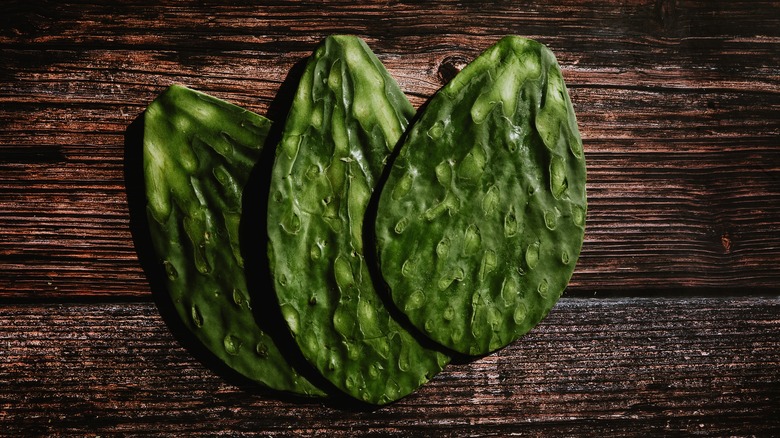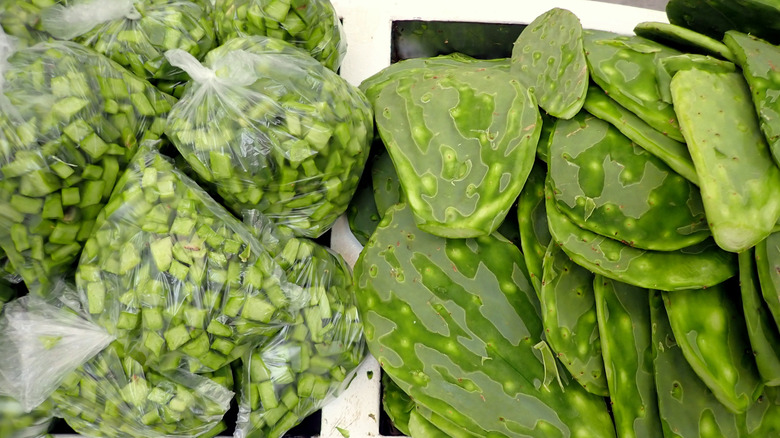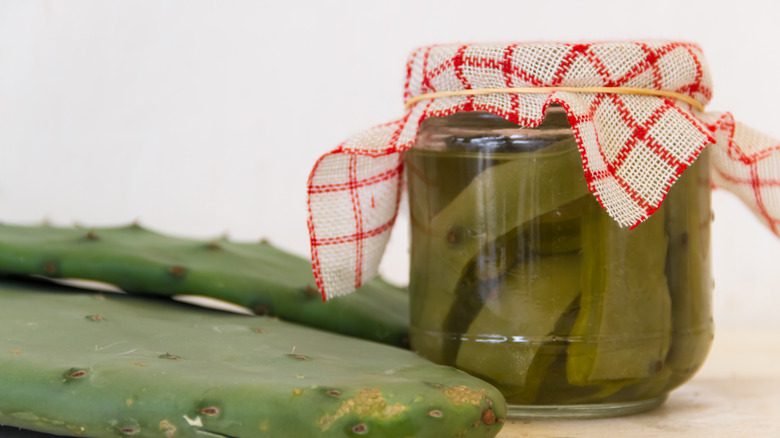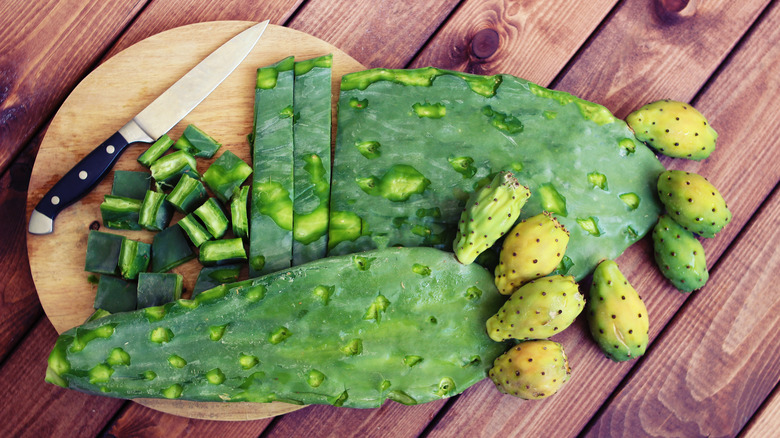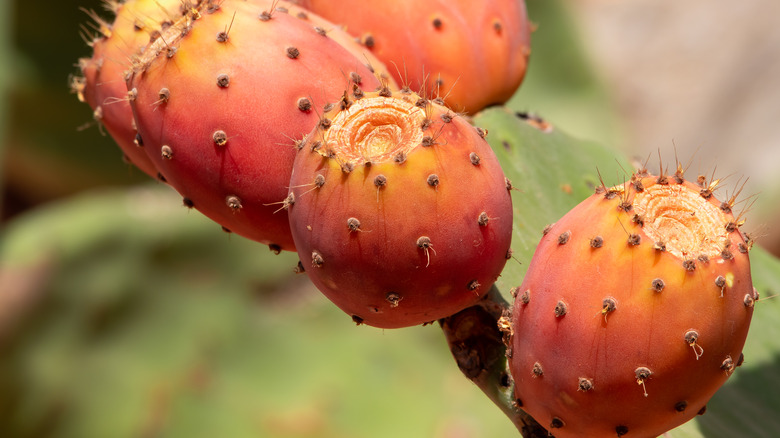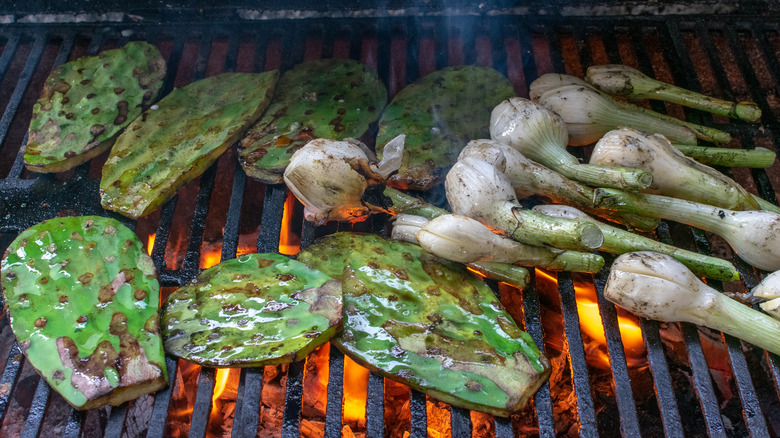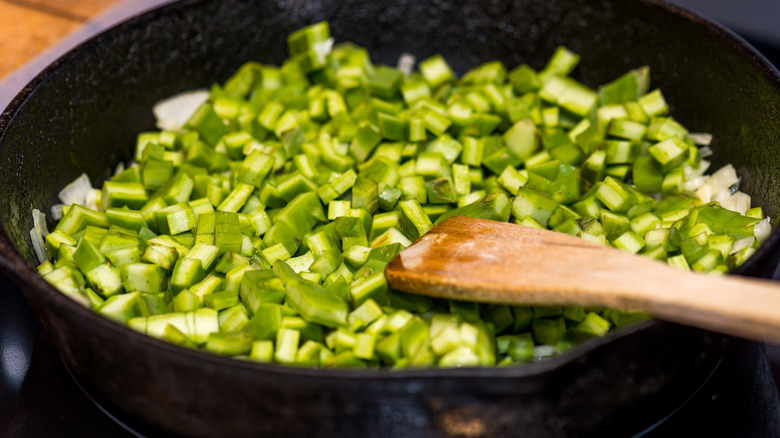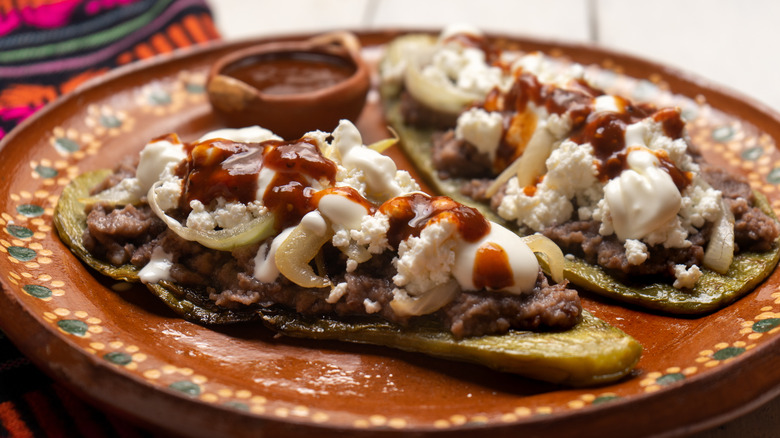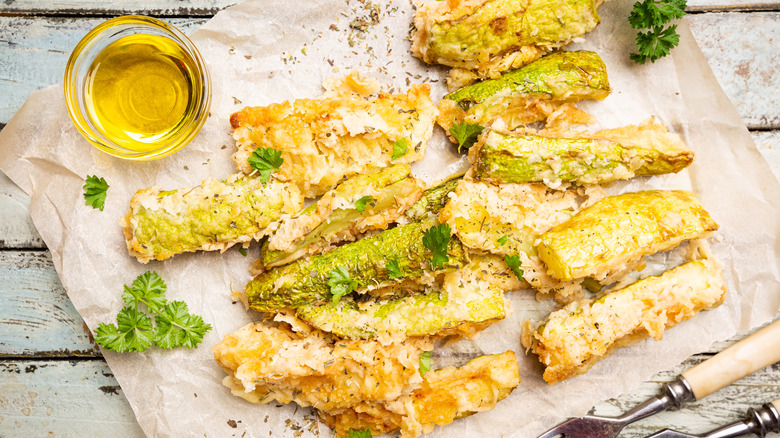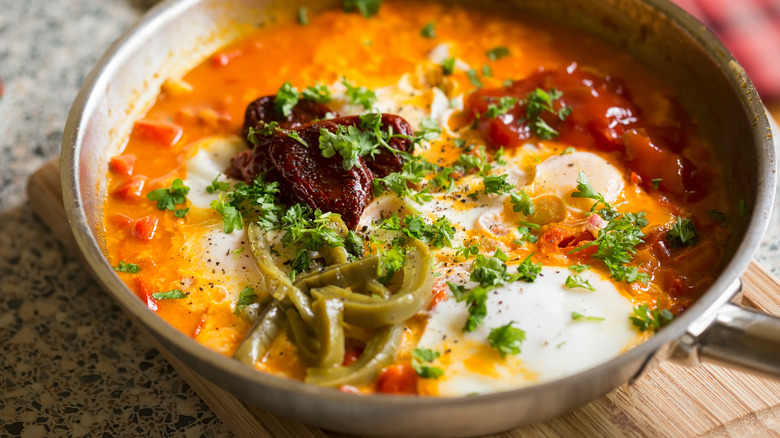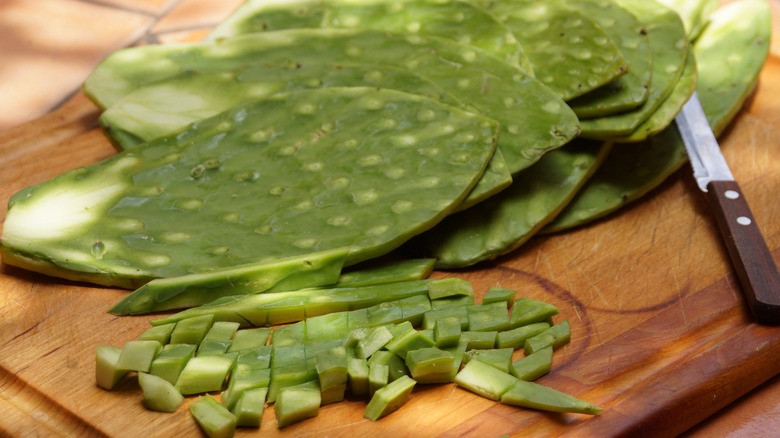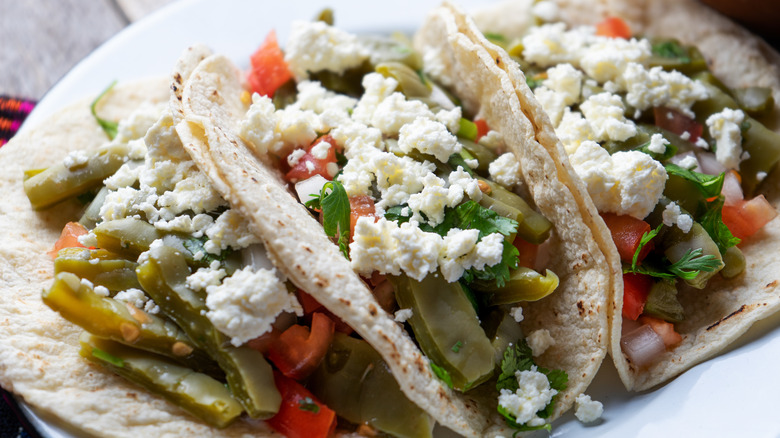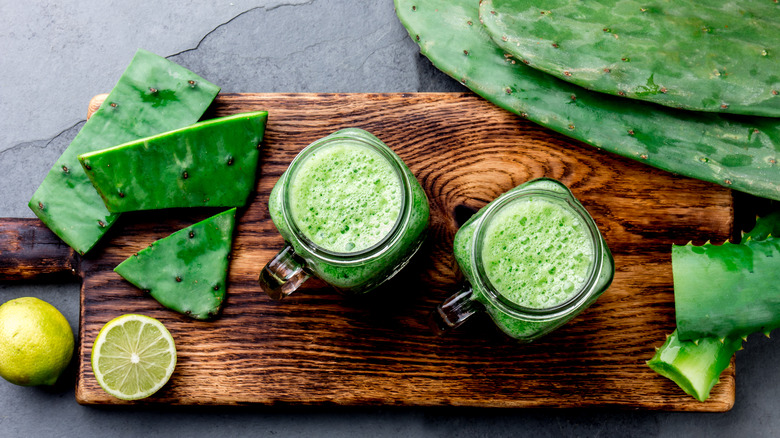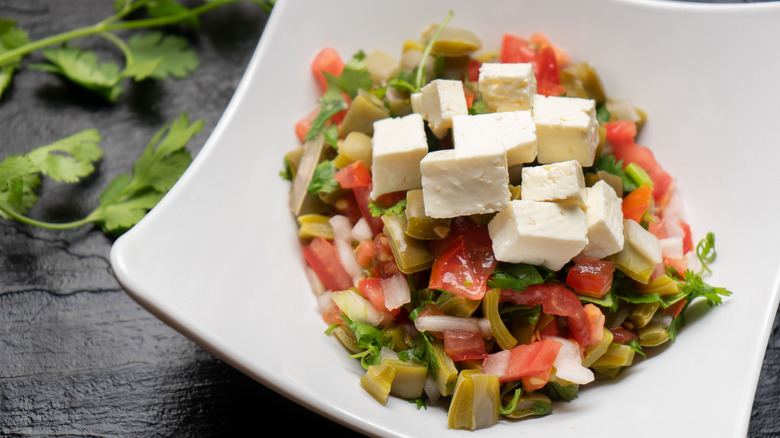13 Tips You Need When Cooking With Nopales
Have you ever bitten into a cactus? While you may have heard of prickly pear cactus fruit, eating cactus paddles might feel like a stretch. Aren't they covered in needles, after all? Although this plant may seem intimidating to dig into, cactus paddles are quite tender and delicious if you follow the helpful tips you need when cooking with nopales.
Whether you've clicked on this article because you were wondering what the heck nopales are or if you grow them in your backyard and are ready to serve 'em up, it's important to understand what exactly you're drooling over. Nopales are paddles typically harvested from the Engelmann prickly pear cactus per Amazon-Sonora Desert Museum. That's right; these tasty ingredients are those flat, tear-drop-shaped prickly outshoots found on our favorite desert plant, wedged right underneath those stunning pink prickly pears.
Nopales can typically be found in traditional Mexican dishes but are slowly beginning to work their way into the trendy foodie community. Even though this unique plant may seem intimidating, it is quite versatile and can be prepared to complement almost any savory dish.
Selecting the right variety
For those of you living life in the American desert climate, fresh nopales can often be found at your local grocery store or even grown in your own backyard. If you keep a windshield scraper and extra blanket in the trunk of your car, you may have to opt for the jarred version when cooking with nopales. Sometimes, even in the northern states, select grocery stores will carry unique imported produce like plantains, starfruit, aloe leaves, and even nopales. While these items may be stapes in southern states and South America, northerners are often considered lucky to get their hands on them.
If you've never owned snow boots, you may have a choice of a few varieties of nopales. According to Texas Master Naturalist, there are over 200 varieties of prickly pear. FoodPrint explains that nopales are nutrient-dense and contain high levels of vitamin C, calcium, manganese, and magnesium. There is quite a bit to this vegetable, or is it a fruit? Technically, cacti are both a fruit and a vegetable, as they contain elements of both, as described by Garden and Me.
Choose between jarred or fresh
Fresh paddles take a bit of prep work; after all, we don't want you chomping down on a cactus needle. When selecting nopales, be sure to find plants with bright green coloring and firm paddles. They should not feel rubbery or flop over when held. When bought from a market, the spines (needles) have been removed. Fresh nopales are best for grilling, roasting, and frying. They tend to be firmer, and because they are in the form of a paddle, they are easier to manipulate in the oven or over an open flame. Cactus paddles can also be eaten raw, and as a rule of thumb, fresh produce is often tastier than jarred.
If jarred nopales are all you can get your hands on, don't worry. They are delicious, tender, and ready to add to any salad. Your prep time just decreased considerably, and you can even eat them right out of the jar.
Kitchen Appliances HQ describes nopales as tasting like a cross between okra and bell peppers. They are a little tangy and slightly bitter, with a hint of sweet and citrus undertones. Similar to okra, prickly pear cactus paddles tend to get a little slimy when cooked, but this is normal. As for any canned vegetable, adding a little citrus can help bring their flavor out.
How to prepare fresh nopales
If your local grocer carries nopales, they will have been prepped already, so you can wash them like you would any other vegetable and get chopping. For fresh nopales from you or your neighbor's yard, you're going to want to get out a hefty pair of work gloves. Their spines are designed to keep predators at bay, and in this case, you're the predator. Run a sharp knife away from your body, down the flat side of the paddle. Lightly scrape until all the needles have been removed, and carefully dispose of them per the Food Literacy Center. Be sure to cut deep enough into the flesh so that you remove the cactus areoles at the base of each spine. You'll want to double-check that each spine has been fully removed before you're ready to chomp.
After the paddles are clean and smooth, decide how you'd like to cut your veggie. While dicing the plant works well for panfrying, you might consider leaving the paddle whole for grilling.
Enjoy the whole plant
Have you ever had a prickly pear-flavored jelly bean? Maybe you've enjoyed a prickly pear cocktail or even xoconostle. Many folks in southern states and Mexico even enjoy prickly pear juice, per Medical News Today. Well, the prickly pear fruit, which bares that unforgettable sweet and tangy flavor, grows right out of nopales. This means that the majority of this plant is entirely edible and offers a variety of flavor sensations. In addition, the two flavors pair exceedingly well together (no surprise there).
Both parts of the plant are nutritious and quite flavorful. When prickly pear fruit reaches full maturity, they become deep reddish-pink and are often called "cactus figs" because they resemble the shape and texture of figs. What does prickly pear taste like? They have a tart-like sweetness, as described by Edible Monterey Bay.
If you're cooking with nopales and making a savory dish, consider garnishing it with prickly pear fruit and adding a smear of prickly pear jam to complement the cactus flesh.
Season and grill nopales
Perhaps the most rustic way to eat cactus paddles is on the grill. Their meaty texture and thick paddles are perfectly designed to hold up on those iron grates.
After thoroughly washing your cactus paddle, rub it in the oil and seasoning of your choice. Smokey, spicy, and sweet rubs pair nicely with grilled nopales. They carry a mild flavor, per Food Guys, so even just your standard salt and pepper seasoning works beautifully. When in doubt about any grilled vegetable, mix a little oil with soy sauce or tamari, garlic powder, and lemon juice. After preheating the grill, let each side roast for about 4-6 minutes or until it begins to tenderize.
If you're worried about losing your paddle between the grates or would like to infuse them with a smokey flavor, consider grilling with wood planks. Remove them from the heat, and enjoy them as a side dish or at the center of your plate.
Cook with nopales on the stovetop
As perhaps the most popular way to cook vegetables, it may come as no surprise that sauteeing diced nopales is a fantastic move. Start by heating your pan or wok and adding a little oil or fat. Duck fat and bacon grease both complement the cactus well and add an additional depth of flavor.
For a lighter alternative, try cooking fresh nopales in a little water or a dry skillet with a lid. Let the paddle soften and blister slightly before removing it from the heat. Add your cooked cactus to stir-fries, enjoy as a side dish, slice and use to top a protein, or enjoy as a snack.
Although the cactus slime might be slightly offputting to some, it's loaded with nutrients. If it's not for you, simply rub the nopales in a little salt and let them sit for about 20 minutes, per oneHOWTO, and wipe the slime off. While slime is often an indicator that a vegetable has gone bad, this is simply a result of a natural substance produced by the plant and is not harmful.
Roast cactus paddles in the oven
Looking for a hands-free way to enjoy cacti? One of the easiest ways to prepare those prickly paddles is roasting nopales. The Minimalist Baker suggests roasting vegetables at 400 F in order to keep them from drying out. Before roasting vegetables, lightly cover with the oil and seasonings while the oven is preheating, and keep a close eye on your nopales. They should take no more than 30 minutes to become tender on the inside and begin to crisp on the outside.
Roasted cactus can be used as a sandwich filler, a salad topping, or even the main course. Because of its unique flavor, it's unnecessary to overly season, although it makes a great vehicle for any sauce. When in doubt, use flavorings from the Southwest and South America. It's never a bad idea to turn up the heat and add a little chipotle or chili powder to the mix.
Make cactus fries
Let's be honest; everything tastes better deep-fried. Nopales are no exception and make incredibly unique and surprisingly delicious fries. Your convection oven and air fryer can work just as well to create this tasty treat. Step aside zucchini fries because nopales fries are here to stay.
Simply use your favorite zucchini fry recipe or veggie french fry alternative and swap out the main ingredient for your new favorite prickly partner in crime. The natural slime of the cactus will help your batter or breading to stay on, but if you'd prefer, you can wipe your fry-sized slices clean before tossing them in the fryer.
Don't overcrowd the fryer, per Blue Jean Chef, in order to allow the hot air to circulate and reach all sides of each fry. This appetizer pairs beautifully with ketchup mixed with a hint of prickly pear jelly or a lime and garlic aioli. They are also delicious when seasoned with paprika, garlic powder, a little sea salt, and crushed black pepper.
Pickle nopales
Where are my pickle people at? Pickle enthusiasts know that almost anything can and should be pickled. There is nothing like that power-packed punch of flavor that comes with each crunchy bite. Luckily, nopales pickle beautifully and can even be sweetened by their own fruit, the prickly pear. This addition will also give your pickles a warmer hue, as the bright red color from the fruit will seep into the flesh of the paddle.
Simply replace cucumbers with sliced nopales in your favorite pickle recipe. America's Test Kitchen explains that quick pickling can be a safe alternative for pickling newbies. Quick pickles are easy to make, and you can enjoy them in a matter of weeks. Pickled cactus makes for an incredible garnish on tacos, nachos, salads, or even protein dishes. They add a punch of vinegar flavoring and help to break up rich or heavy dishes, similar to a palate cleanser. Use either fresh or jarred nopales for your next pickling excursion.
Eat nopales raw
Surprisingly, nopales can be eaten raw, and although they are slightly bitter, they have a unique and enjoyable texture. Raw nopales are best eaten when diced and mixed with other ingredients to distribute their flavor and mellow out any bitterness. Diced nopales can be added to salads, enjoyed as a garnish, topped on soups, and mixed in with other veggies. Thin slices can be enjoyed on sandwiches, and per FoodPrint, you can even make salsa with them. In fact, they are an incredible ingredient to add to any salsa because of their crunchy texture and moisture retention.
Because of their nutrient density, nopales make great toppings for almost any dish and can even be mixed with their prickly pear cactus fruit. This combination creates a sweet, tangy, and slightly bitter topping with an added crunch. Consider them as a snack, or even feature them on a Southwestern-themed charcuterie board alongside panela, prickly pear fruit, and chili chocolate.
Feature nopales in tacos
Because of their region of origin, it's no wonder these prickly vegetables feature beautifully in Mexican and American Southwestern cuisine. If you're a taco fanatic, you may understand the key elements to create a balanced mouthfeel. A combination of varying flavors and textures helps give those loveable corn pockets their sparkle. A little crunch, a little fat, a little tang, and just a touch of something creamy can make your taco creation go from flat to fabulous in minutes.
Nopales contain several of these elements and make for a delicious base ingredient. Replace carnitas or steak with grilled cactus. This authentic addition can be cooked as is or marinated with smokey and spicy sauces or rubs. Be sure to include other regional ingredients like cotija, lime, cilantro, salsa, avocado, and corn. Finally, top with pickled red onion or thin slices of pickled prickly pear fruit. Remember, just an addition of a simple toping can give your tacos a tangy kick.
Make a green smoothie
Yes, green smoothies are trendy. But there is a reason behind their recent stardom. Incorporating leafy greens into your diet can help with brain function per the National Library of medicine. Another study published in the National Library of Medicine suggested that even just the addition of 3 leaves of spinach a day can cut the risk of certain cancers by one-half. It's no wonder green smoothies have gained popularity, especially because only one in 10 Americans are eating their recommended daily allowance of fruits and vegetables, as concluded by the CDC.
Cacti are technically both a fruit and a vegetable, so it's no surprise that they make the perfect smoothie addition. Double-check that all prickers have been removed. Because of their slightly bitter taste, be sure to pair them with sweet fruits like bananas, dates, or pineapples. Nopales pair beautifully with prickly pear fruit and avocado as well, so consider adding some to your shake. Don't forget to make it green by adding a handful of spinach or kale!
Build a salad
Especially if you're working with jarred nopales, consider using them in a salad. Remove the cactus vegetable from the liquid in the jar. Toss with onion, cilantro, tomato, cotija cheese, lime juice, and a dash of Mexican oregano. This simple and authentic salad is regionally popular, and for a good reason.
If you're working with fresh nopales, you can use them raw or cooked. Typically, the prickly vegetable is cooked before it's used in a traditional nopales salad, but it also makes a delicious topping. Think of raw nopales like green pepper when adding it to your favorite tossed salad recipe.
Follow a few simple steps to prep and cook nopales for salad. After removing the prickers and washing the paddles, slice the cactus into long thin slices. Steam them slightly in a pan with hot water for a few minutes. Drain them, or let the water evaporate. Consider tossing them in olive oil and lime juice before incorporating them into your salad.
